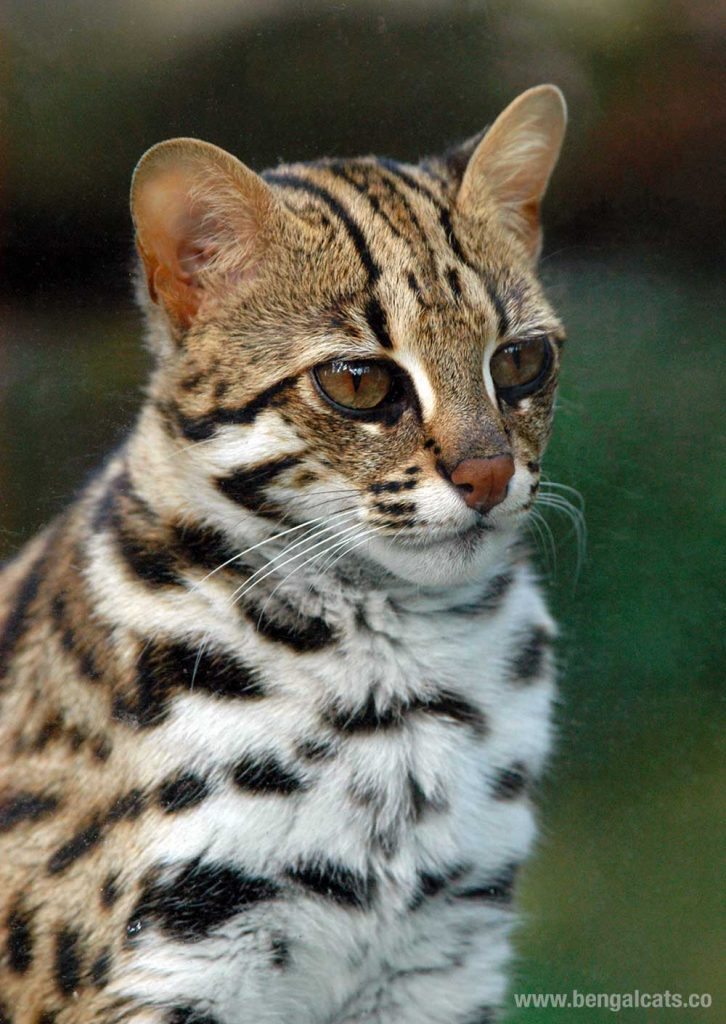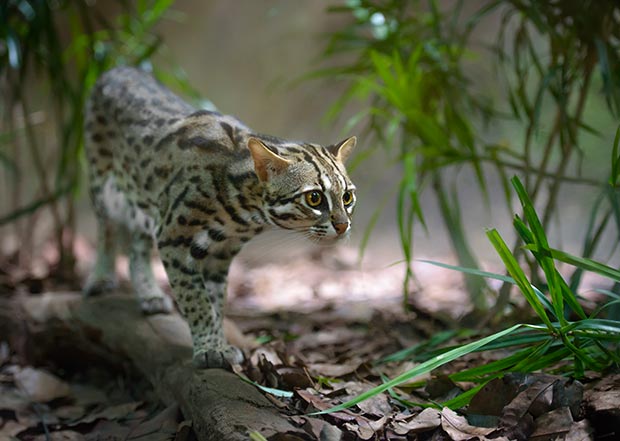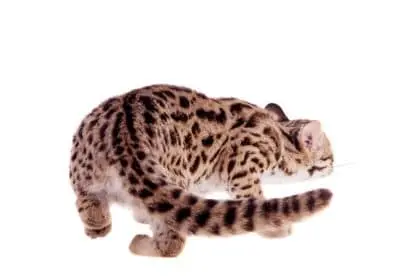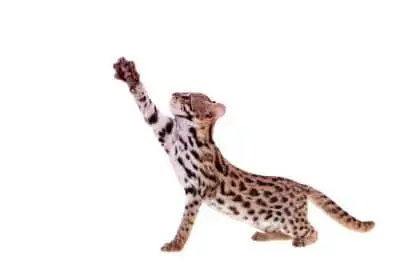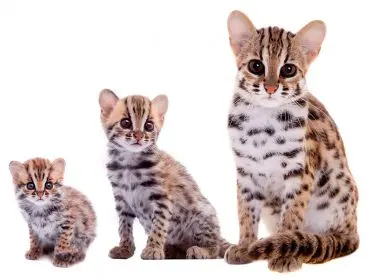[dropcap]T[/dropcap]he ancestry of the Asian Leopard Cat (abbreviated ALC) derives from a spotted domestic cat and a small wild spotted feline called the Mainland leopard cat or Prionailurus bengalensis (scientific name).
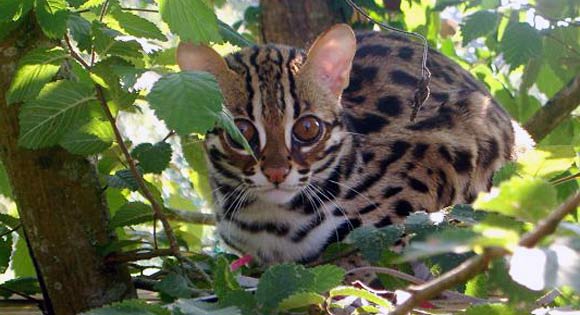
The Bengal’s wild progenitor
Though many people call them “Asian Leopard Cats” (ALC), technically, the exact species name is “Leopard Cat” Prionailurus bengalensis.
Several subspecies of these little spotted felines have been described, and they range from 3 to 20 pounds in weight.
Being small predators, they are right in the middle of the food chain and are shy, nocturnal, and afraid of humans and larger predators which have been hunting them for centuries.

Embed our infographic image on your site:
You can copy and paste the above code on your website to embed this infographic.
Just press command+c on Mac or control+c on Windows to copy embed code.
Distribution and habitat of Asian Leopard Cats
Leopard cats are indigenous to a large part of southern Asia. They can be found in agriculturally used areas, deep jungles, and forested habitats from southern India eastward through Bangladesh, Burma, Thailand, Malaysia, China, Korea, and into Russia’s Far East.
Recently, Leopard cats from the Sunda Islands, such as Sumatra, Borneo, Bali, Java, and the Philippines have been recognized as a separate species, the Sunda leopard cat (Prionailurus javanensis).
Based on genetic studies two subspecies of the Mainland leopard cat are tentatively recognized:
- Prionailurus bengalensis bengalensis in South Asia from Pakistan to China and probably the Malay Peninsula.
- Prionailurus bengalensis euptilurus (Amur Leopard Cat) in Russian Far East, Manchuria, Taiwan, Iriomote Island, and Tsushima Island.
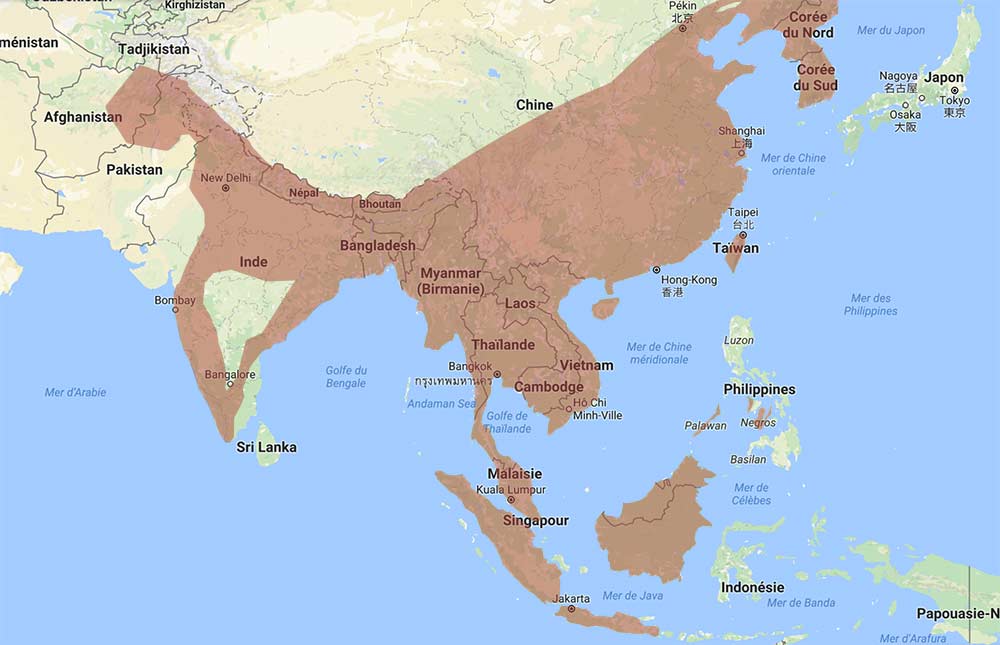
Hunting and diet of Asian Leopard Cats
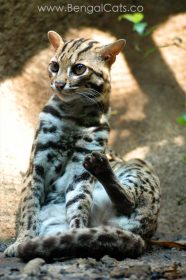 ALCs are known to eat mostly small birds, rodents, amphibians, reptiles, fish, and insects in the wild. Some of them occasionally venture into farmyards to prey on domestic chickens.
ALCs are known to eat mostly small birds, rodents, amphibians, reptiles, fish, and insects in the wild. Some of them occasionally venture into farmyards to prey on domestic chickens.
It is said that when ALCs attack and kill their victims, they go straight in for the kill rather than playing with their prey as if they were toys
Hunting usually takes place at night and their climbing skills allow them to spend days resting in tree hollows or caves.
Characteristics and morphology
The general build of an Asian Leopard cat is somewhat similar to a house cat, but their torso is long and substantial and their legs and body are much longer (25 to 32 inches from head to tail) than normal domestic cats. Hind legs are slightly longer than the forelegs. The tail is thick and medium in length (11 to 14 inches) with a rounded tip. Paws are large with prominent knuckles.
Colors and markings
- Head: Four vertical black stripes run from the forehead or inner eye corners to the back of the neck, breaking up into short irregular rows of dark markings and elongated spots on the neck and shoulders, although sometimes one stripe runs the length of the entire body. Two narrow black cheek stripes run from the outer eye corners, enclosing a white area on the cheek. The back of their ears are black with the exception of a white triangular-shaped spot.
- Coat: It’s primarily the spotted coat that suggests “leopard”. ALCs exhibit well-defined dark spots spread all over their body that can be solid or rosetted and sometimes marbled. The base coat varies in color depending on the cat’s geographical areas of origin and ranges from different shades of tan (beige to golden), gray or tawny brown. The chin, throat, belly, and interior parts of the legs are white with black spots.
- Pads: The color of their toe pads varies from dark purple to dark brown. The carpal pads, found on the forelegs, are very light pink.
- Tail: All Asian leopard cats have a spotted or ringed tail whose tip is black.
Asian Leopard Cat & Domestic Bengal Cat
The history of the Bengal breed started in 1963 when Jean Sugden Mill first documented hybridization between Prionailurus bengalensis and Felis catus (domestic house cat).
The mainland leopard cat was found to be the ideal candidate for hybridization to give rise to the exotic breed of wild-looking house pet known as the Bengal cat.
[box type=”warning” align=”” class=”” width=””]The leopard cat is a wild animal and shouldn’t be bought or sold as pets. They do not make good pets. So many are taken from the wild, and often the mothers are killed or separated from kittens to take them for the illegal wildlife/pet trade.[/box]
Pictures of Asian Leopard Cats
